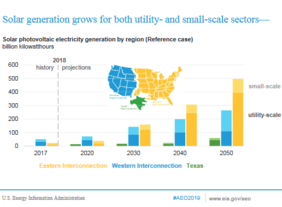The US Energy Information Administration released its Annual Energy Outlook (AEO) 2019 with projections to 2050. The intention of the AEO is to provide long-term energy projections for the United States, based on the study of several reference cases analyzing forecast developments in energy prices and technologies, as well as economic and demographic trends.
According to the AEO-2019, the United States will export more energy than it imports, becoming a major net energy exporter in 2020 for the first time in 67 years and will remain so throughout 2050 due to large increases in crude oil, natural gas, and natural gas plant liquids (NGPL) production. At the same time, a slower growth in U.S. energy consumption is expected over the projected period.
The key points from the AEO-2019 are:
- Massive shale reserves are projected to continue to set records delivering higher volumes of crude oil and natural gas.
- Crude oil production is predicted to grow, reaching approximately 15 million barrels a day through to 2040. Natural gas production should reach 43 trillion cubic feet by 2050.
- The amount of dry natural gas production from oil formations increased from 8% in 2013 to 17% in 2018 and remains approximately at this level through to 2050. Large volumes of natural gas from oil formations will lower prices on natural gas.
- Tight oil and shale gas resources stimulate growth in natural gas liquid production, which is forecast to reach 6 million barrels a day by 2029.
- Natural gas and NGPLs have the fastest production growth rates among all fossil fuels.
- Natural gas prices remain comparatively low through to 2050, resulting in growing usage across end-use sectors and higher liquefied natural gas (LNG) exports.
- The US power sector proceeds to move from coal and nuclear plants toward natural gas-fired and intermittent renewable electricity generation.
- Renewables consumption grows nearly twice as fast in the electricity sector (1.7% per year) than in the industrial sector (1.0% per year). The share of renewables increases from 18% in 2018 to 31% in 2050, driven largely by growth in wind and solar generation.
- The share of solar power among renewables is predicted to grow from 13% in 2018 to 48% in 2050. Residential solar photovoltaic (PV) capacity increases by an average of 8% annually from 2018 through 2050.
- Although the U.S. economy continues to expand, growing energy efficiency keeps the energy consumption in the country relatively flat.
